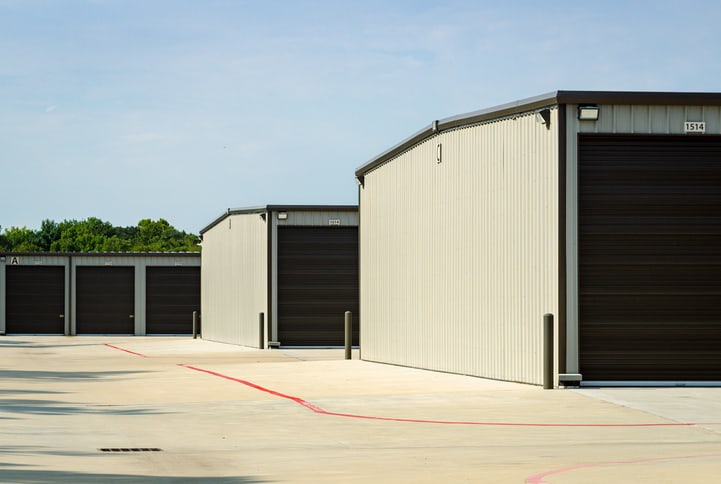Homelessness & Self-Storage: How to be Compassionate While Preventing Live-in Renters

There’s nothing more sobering than the sight of a person living unsheltered out in the cold. As a passerby, you’ll likely want to help in some way – maybe by buying them a hot meal or a safe place to stay for the night. It’s always sad to see people living in unfortunate circumstances.
For self-storage owners and managers, rising housing costs and homelessness present another problem: live-in renters. Oftentimes unhoused individuals or families in a desperate situations turn to storage units as a cheap place to live. However, self-storage units aren’t safe for human habitation, and people living on the premises presents a negative environment for other renters. That makes it the job of every storage manager to detect and deal with unwelcome inhabitants.
If you’re a veteran of the self storage industry, you’ve likely come across this situation at your own storage property. Every situation is different, and sometimes it’s difficult to know what to do.
Maybe you’ve suspected a tenant is homeless, but you’re not sure, or you’ve had to turn away an increasing number of people who are in desperate need of shelter and looking to rent a unit.
The problem of live-in renters is heartbreaking, but also frustrating for storage business owners and their staff. As a storage owner or manager, there are steps you can take to prevent live-in renters while still being compassionate and kind to those who are less fortunate in your community.
The problem:
Depending on where you live, homelessness might be a nearly invisible problem, but not for residents of major cities like Los Angeles, Honolulu, or Washington, D.C.:
- Hawaii has a large number of homeless statewide, with many homeless encampments spanning miles, a large number of families living (and even babies being born) on the street.
- Los Angeles and New York City have the largest homeless populations in America, with over 58,000 homeless in LA and more than 62,000 homeless living in NYC.
- Close to 10% of homeless people are veterans, and Washington, D.C. has the highest number of homeless veterans in the country. Over 40% of homeless youth identify as LGBTQ, and 1 in 45 children will experience homelessness each year.
So how does this happen? Higher living cost is a contributing factor. Many impoverished people are at risk of homelessness because it is hard for them to afford housing. Over 7 million U.S. families are paying more than 50% of their income to housing, a problem that is especially prevalent in cities with unusually high housing costs like San Francisco, Denver, New York, and Washington, D.C.
The opioid epidemic is also a contributing factor in some areas. In October 2017, America’s opioid crisis was declared a public health emergency. People experiencing homelessness are often entangled in the midst of the epidemic – widespread addiction rates are contributing to a worsening homelessness rate in many communities. With prevalent drug use and little resources, homeless and impoverished populations may find it difficult to find safe housing, leading to chronic homelessness.
Attempts to provide housing or support for the unhoused is often met with local opposition. The majority of city, state, and municipal governments across the country have failed to allocate adequate funding needed to eliminate homelessness in their communities.
The situation:
All of these people need a place to sleep tonight. They could sleep in their car, call a friend and ask to stay on their couch, or camp out on the side of the street. Compared to sleeping on the sidewalk, staying in a storage unit starts to sound like a more and more attractive option – especially if the unit is climate-controlled and the weather outside is freezing.
Regardless of the situation, it is illegal to inhabit a storage unit – the law prohibits both animals and humans from living in storage units. If you need to explain to your renters why living in a storage unit is a bad idea, here’s a brief overview of why they should not:
- The tenant could die. It’s unsafe for both the other tenants and the live-in tenant. There are no smoke alarms, storage unit doors aren’t designed to be opened from the inside, and the building is not zoned as a residence. Tenants who smoke or attempt to cook food in their unit could start a fire and become trapped inside. Live-in tenants can also create fire hazards and dangerous situations for other tenants of the facility, compromising your facility security.
- It is unsanitary. There is no running water inside of storage units, which means no place to use the bathroom, or to wash your hands or shower.
- The tenant could go to jail. Sooner or later (likely sooner), the tenant will be caught and the situation will likely be handled by police. If children are involved, Child Protective Services could try to permanently remove the children from the tenant’s custody. This becomes a very serious legal situation for the tenant quite quickly.
- It violates the tenant’s lease agreement. The tenants’ rental agreement specifies that they may not live in the unit. (Or as I’d put it, the classic “because I said so!” response.) Due to the terms of the lease, a tenant who violates the lease will be guilty of a civil offense. As an owner, you’ll be liable for damages if you knowingly allow a renter to live in their storage unit and turn a blind eye.
No matter how bleak their living situation or how nice the tenant is, as a manager, you cannot permit or allow tenants to live or spend the night in their storage unit. It’s illegal, dangerous, and could lead to life-threatening situations for other tenants. So what should you do? You have a few options.
What to do
For a storage owner, every situation is different. Sometimes it might be tough to know what to do – you might not have solid proof that a tenant is living in his or her unit. You could just suspect that something shady is going on or that your renter is struggling to get by. Always listen to your gut, and when in doubt, seek the help of others, whether that means contacting your partners in management or reaching out to local police. If you’re encountered with one of the three below situations, follow these helpful steps to both stay safe and be compassionate.
What to do if you find a tenant living in their storage unit:
If you catch a tenant living in his or her storage unit, you need to evict them (and their stuff) from the unit immediately, or else the tenant (and you!) could face criminal charges – especially if there are children involved. There are steps to do this safely:
- Never approach anyone living in a unit by yourself. Call for the police (or at least get backup from other managers) to assist you in evicting a tenant who is living in their unit. While it’s not a universal truth, in some instances people who are living in a storage unit are doing so to avoid police. They may be under the influence of drugs or alcohol or hiding illegal activity, and they could become aggressive or violent when asked to leave or vacate the property. By fostering excellent relationships with local law enforcement, you’ll be able to ensure your safety by having a police officer present when you ask the tenant to vacate.
- Keep detailed records. If the police become involved further than simply helping remove the tenant, you’ll need to supply detailed records, such as security footage, gate log records, keypad activity, manager-on-duty records, all payment history, and more. The more detailed your records on the tenant, the safer your business will be in the event that the tenant takes legal action against your facility.
- Increase security. If the tenant is behind on their rent and they are asked to vacate the property, prepare for backlash. They may try to continue to access their unit by camping out in front of the property, breaking into the facility, or worse. Protect your property and your paying tenants by increasing security – ask a police officer to drive through the facility over the next few nights and closely monitor cameras. Do walk throughs more frequently and at irregular intervals in the early mornings and late evenings.
How to help tenants who you suspect are homeless:
Obviously, you can’t allow homeless tenants to sleep in their storage unit. But it can be hard to simply kick them to the curb – as a charitable, giving person, you want to help because it’s the right thing to do. You likely can’t afford to shell out $100 for a hotel room every time a less fortunate person comes by your office, so what should you do? Follow these steps to help renters who you suspect are experiencing homelessness.
- Be firm, but kind. Your stance is simple – no loitering and no sleeping your unit, no ifs, ands, or buts about it. Don’t embarrass them in front of others, but be firm about your policy. Offer a kind ear and be sympathetic to your tenant’s troubles. Just because you’re not going to allow them to live in their storage unit, doesn’t mean you’re their enemy.
- Offer information on local shelters and resources. By having pamphlets on local shelters, transition assistance services, food pantries, soup kitchens, churches with open doors, and affordable housing options available behind the counter, you’ll be able to do more than just show people who are struggling the door. If you don’t have pamphlets available, simply print out something for the tenant with information on where the nearest shelter is, how to get there, what days they’re open, and what time they close. Reach out to nearby transitional homes and ministries – they’ll likely be able to help you with these tough conversations and provide advice.
- Don’t offer money or your personal information. While you want to help and be sympathetic, do not allow tenants who you suspect are homeless to cash in at your office or get access to your personal information. It sets a dangerous precedent for panhandling and tenants crossing the line in a way that affects your personal safety.
- Volunteer your time at a local soup kitchen. If you continue to feel guilty about turning away those experiencing homelessness from your business, volunteer your time at a local soup kitchen or food pantry. Get involved in the community’s action plan for assisting those who are struggling to find affordable housing or experiencing homelessness. As a self-storage owner or manager, you have more firsthand knowledge than most, and your personal experiences can make a positive difference in your community.
- Host a food drive at your facility. This is another great way to get directly involved in giving back to those who are less fortunate in your community. Host a charity drive by setting aside a corner of your office or an empty storage unit for non-perishable food donations, toiletries, gift bags (with essentials like toothpaste, deodorant, bus passes, and more), or toys for children. Make arrangements to donate the items to a local charity that can get them to those who are struggling, then publicize your charity event and start collecting donations!
Lastly, know that choosing not to rent to a person you suspect is homeless and will try to live in their unit does not make you a bad person. You have a business to run, security to uphold, and tenants’ belongings and safety to protect. You can still be helpful and kind to those who are in desperate situations while protecting and upholding the security of other tenants.
How to prevent future tenants from living in your storage units:
To prevent more tenants from trying to live in their units in the future, follow these steps. You’ll boost security, deter illegal activity, inform your tenants, and teach your team how to watch out for illegal activity.
- Maintain strict security standards. Keep a gate log, do walk-throughs of the property, check video recordings against your gate log, and inspect storage units on a schedule. Tenants who are thinking about camping out will be deterred by your vigilance.
- Make your storage units uncomfortable to live in. Even if you offer climate-controlled units, there are steps you can take to make living in the unit more difficult. Install motion-sensor lights, lock bathroom doors, shut off hot water at your facility, cut off electrical access to units, and perform routine maintenance. With enough deterrents, stowaway tenants will realize staying on site is not a viable option.
- Train your managers to watch out for unusual activity. A great start would be with this blog post! By simply teaching your managers to watch out for loitering, unusual activity in the gate access log, and atypical activity on camera, you’ll be able to spot a renter who is hoping to live in his or her unit. Other signs include extension cords running to units and bathrooms being used over night.
- Teach your managers how to approach tenants who they suspect are living in their unit. They should also be taught how to decline service to customers who are wanting to rent a unit in order to live in it.
- Make it clear in your lease agreement. If it is already crystal-clear that your stance against living in your unit is firm, make it more clear. Go over what the consequences are for living in your storage unit are, draw attention to the statement, and have the renter initial it. Inform new renters of your video monitoring and gate log practices. You’ll deter tenants who are hoping to sneak by unnoticed and stay overnight in their unit without getting caught.
Stay firm
As a storage owner or manager, you’re in a unique situation in which you frequently meet people who are in a transitional period of life. When others are struggling and you want to help, it can be difficult to stick to your guns. Remember that you can be kind and helpful to those who are facing homelessness while still taking a firm stance against live-in renters at your facility and maintaining strict security standards.
At the end of the day, it’s important to listen to your gut. Whether a tenant is homeless or not, if they give you a bad vibe, try to skirt the rules, or are disrespectful to management, don’t be afraid to just say no. Remember that your business’s reputation can be tarnished by a terrible tenant, and your customers are relying on you to maintain the safety and security of the facility by weeding out bad apples. Be careful, be kind, and use your best judgment!
Related Resources:

How to Start a Self-Storage Business
Launching a self-storage business for the first time? Start here and learn everything you need to know before you buy or build. Keep Reading

3 Brilliant Advertising Campaigns Storage Operators Can Learn From
Need a little inspiration for advertising your self-storage facility? Check out these three examples to get your creative juices flowing. Keep Reading

How Much Does it Cost to Build a Self-Storage Facility?
When you’re looking to develop a self-storage facility, you obviously must decide where to build it. Be prepared, finding a great site for storage can be tricky. Keep Reading